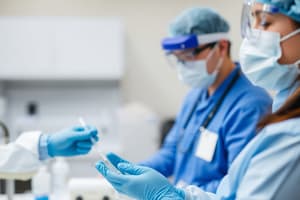Podcast
Questions and Answers
Match the specimen type with its collection method:
Match the specimen type with its collection method:
Body Fluids = Collect using a sterile needle and syringe Throat Swab = Use a cotton swab after good visualization Middle Ear Fluid = Collected by tympanocentesis Corneal Scrapings = Inoculate directly onto bacterial agar media
Match the specimen type with its required transport conditions:
Match the specimen type with its required transport conditions:
Bronchial Wash = Transport immediately at ambient temperature External Ear Cultures = Processed as superficial wounds Purulent Material from Eye = Transport in appropriate media at ambient temperature Intraocular Fluid = Transport cultures at ambient temperature
Match the specimen type with its minimum volume for collection:
Match the specimen type with its minimum volume for collection:
Body Fluids (aerobic/anaerobic) = 10 ml in a sterile container Fungal Hair Specimen = Placed in a dry sterile container Nail Specimen = Scrape to collect the outermost layer Corneal Infections = Multiple scrapings collected for culture
Match the microbiological study with its specific collection hint:
Match the microbiological study with its specific collection hint:
Match the type of specimen with its acceptable alternatives:
Match the type of specimen with its acceptable alternatives:
Match the circumstance with the specific specimen collection recommendation:
Match the circumstance with the specific specimen collection recommendation:
Match the specimen and the required technique:
Match the specimen and the required technique:
Match the specimen collection technique with the collector's experience level:
Match the specimen collection technique with the collector's experience level:
Flashcards
Sterile Body Fluids
Sterile Body Fluids
A sterile fluid collected using a sterile needle and syringe. Typically 10ml is collected for both aerobic and anaerobic organisms.
Bronchial Brush/Wash/Lavage
Bronchial Brush/Wash/Lavage
This technique should be performed by a chest physician. The specimen is collected in a sterile container and transported at ambient temperature.
Throat Swab
Throat Swab
Use a cotton swab to collect samples from both tonsils, the back of the throat, and any areas of inflammation.
Ear Cultures
Ear Cultures
Signup and view all the flashcards
Eye Cultures
Eye Cultures
Signup and view all the flashcards
Intraocular Fluid Collection
Intraocular Fluid Collection
Signup and view all the flashcards
Hair Samples for Mycology
Hair Samples for Mycology
Signup and view all the flashcards
Nail Samples for Mycology
Nail Samples for Mycology
Signup and view all the flashcards
Study Notes
Specimen Collection for Microbiological Studies
- Body Fluids (excluding urine and cerebrospinal fluid):
- Prepare skin as for blood cultures.
- Collect fluid using a sterile needle and syringe.
- Submit 10 mL of fluid in a sterile container for aerobic and anaerobic organisms.
- For suspected tuberculosis or fungal infections, collect a minimum of 10 mL into a sterile container.
- Transport immediately.
- Do not send sterile body fluids on swabs.
Bronchial Brush/Wash/Lavage
- Performed by an experienced chest physician.
- Transport in a sterile container at ambient temperature.
Throat
- Use a cotton swab.
- Use a tongue depressor and good light source for visualization.
- Swab both tonsillar fauces, posterior pharynx, and any ulceration, exudates, lesions, or inflammation areas.
- Place swab into appropriate transport media and transport at ambient temperature.
Ear
- External ear cultures are processed as superficial wounds.
- Middle ear fluid is processed as a miscellaneous body fluid.
- For otitis media, the specimen of choice is middle ear fluid collected by tympanocentesis (by an experienced physician).
- Indicate the specific ear source.
Eye
- Cleanse skin around the eye with a mild antiseptic.
- For purulent conjunctivitis, collect purulent material with a cotton swab.
- Place swabs in appropriate transport media and transport at ambient temperature.
Corneal Infections
- Obtain culture media from the microbiology laboratory.
- Swab the conjunctiva as described above.
- Collect multiple corneal scrapings and inoculate directly onto bacterial agar media (chocolate agar, sheep blood agar, BHI broth) and/or Saboroud's dextrose agar media.
- Transport at ambient temperature.
Intraocular Fluid
- Collect fluid by surgical needle aspiration (performed by an experienced eye surgeon).
- Transport cultures at ambient temperature.
Mycology Specimens (Fungal Only) - Hair
- Scrap the scalp with a blunt scalpel.
- Place specimen in a dry, sterile container.
- Transport at ambient temperature.
- Hair stubs, contents of plugged follicles, skin scales, and hair plucked with forceps are acceptable.
Mycology Specimens (Fungal Only) - Nails
- Cleanse the nail with 70-95% ALC.
- Remove the outermost layer by scraping with a scalpel.
- Place specimen in a dry, sterile container.
- Transport at ambient temperature.
- Acceptable specimens include clippings from discolored/brittle parts of the nail, and deeper scrapings/debris beneath the nail edges.
Mycology Specimens (Fungal Only) - Skin
- Cleanse the skin with 70-95% ALC.
- Collect epidermal scales with a scalpel, at the active border of the lesion.
- Place specimen in a dry, sterile container.
- Do not tape the specimen to a slide.
- Transport at ambient temperature.
Studying That Suits You
Use AI to generate personalized quizzes and flashcards to suit your learning preferences.



